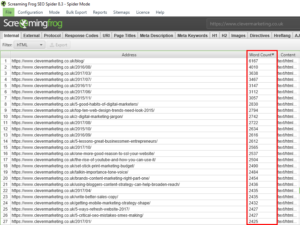Have you heard of the term “thin content” in the world of Search Engine Marketing?
It’s when websites contain very short articles, in their blogs, news channels, or even on main pages and the word count is extremely low.
Why is Being Aware of Thin Content important?
Once upon a time (think 2008), websites stuffed full of content would rank well in the search engines. The high traffic volumes they attracted would then have display ads thrown at them and the website owners would make a nice income.
In fact, for the likes of some websites, their entire business model was built around producing high volumes of low-quality content. It didn’t matter how poor the content was or whether there were numerous and ever-so-slightly different versions of the same piece, each built to draw in organic traffic around a specific keyword. All the website owners were interested in was cheap content, high traffic and earning the revenue from displaying ads.
These websites were called “content farms” or “content mills” and they drove down the value of written content. Writers were paid peanuts and many didn’t complain because they weren’t even professional writers, they simply made extra money on the side.
Some of the websites and blogs built around this model even earned their own name – Made For AdSense (MFA) sites. They had “thin content” and lots of display ads, usually through Google’s AdSense platform.
It was around this time that Google started to get fed up with the poor quality content. Advertisers were unhappy and so were web users too. I remember well, Google’s then CEO Eric Schmidt, calling the Internet a “cesspool” and telling publishers to up their game.
And so, ten years ago, that was what happened; Users got a button on their SERPs to vote down poor quality content and websites with “thin content” started to slip down the rankings, lose traffic and miss out on ad revenue. Some very big content farms went from public flotation on the New York Stock Exchange to relative obscurity. Smaller businesses based on this model disappeared completely.
So What is NOT Thin Content Then?
A word count of 300 words is generally considered “thin content”. That’s about as many words as you’ve read up to this point.
You’ve already learned the background of what thin content is and why there was a crackdown. As a business owner, it’s good to know this background but there’s more…
There have been studies that have also looked at the perfect length of an article. A recent piece indicated that, of a survey of over 1,000 bloggers, the average blog post was 1,142 words.
Working as webmaster for a well-known cycling charity, our own most popular piece of organic content was an article with a word count of around 1,500 words. The Marketing Manager always hated that article and said it was far too long. However, Google Analytics data showed that it was consistently the best-performing page on the whole website, earning many more sessions than the next best pieces.
So, word counts nearing 1,000 words seem to be about right.
That doesn’t mean that you have to write 1,000 words because your subject matter or knowledge of it may not reach that far, but at least that’s a focus point against which to be measured.
In fact, the Ranking Factors 2017 report from SEMrush says that the highest ranking websites tend to have content with a higher word count and indicates that the optimal word count is around the 750 mark.
It’s also worth bearing in mind the context of a web page content too. In their own Search Quality Evaluator Guidelines (PDF) Google says:
A High quality page on a broad topic with a lot of available information will have more content than a High quality page on a narrower topic.
And in any page you publish in your website you need to demonstrate, as Google says, Expertise, Authoritativeness and Trustworthiness (E-A-T).
How to Find Thin Content in Your Website
Now not every content manager or website owner will know all the content on their website. They may have inherited the site from a previous manager or editor and be unaware of the ins-and-outs of the content.
One way to check for thin content is to use Screaming Frog SEO Spider, a tool that can crawl a website and extract all manner of useful data from it. This data can be such as the titles, descriptions, h1s, h2s on every page.
This is all really useful information for content managers and digital marketers, but the data we’re interested in is the word count.

The raw word count will include all the words on a page so you need to take into account all the menu systems, sidebars, boxes, pull quotes etc.
The best way to work out the actual word count is to take a blank page and crawl that for its word count. Or, if that’s not an option, find a page with the least amount of text on it, copy and paste the body text into your favourite desktop word processing package and run a word count there.
Then subtract your body word count from the overall word count of a page in the SEO Spider and you now know what the word count is of menus, navigation etc.
For example, one webpage we looked at had a word count of 304 words and, when we investigated, there was virtually no content – Only an 8-word heading and single word of body copy! That means there were 296 words in every template that were part of the nav etc.
If you now export your SEO Spider data as a spreadsheet you can then filter your pages by the word count to see which pages you need to focus on. You can add more content, or completely rewrite pages to make them more useful to users.
From our example above, we would use our baseline of 296 words, add the 300 minimum count to that and filter any pages of fewer than 596 word count. We can then focus our attention on improving these “thin pages” and make the website far more useful for visitors.
So there you have it – a simple way to crawl your website and identify thin content so that you can upgrade or rewrite any old articles to make them more successful.

Call us on 01276 402 381 or complete our easy contact form.
And in case you were wondering, this article is 1,142 words.
